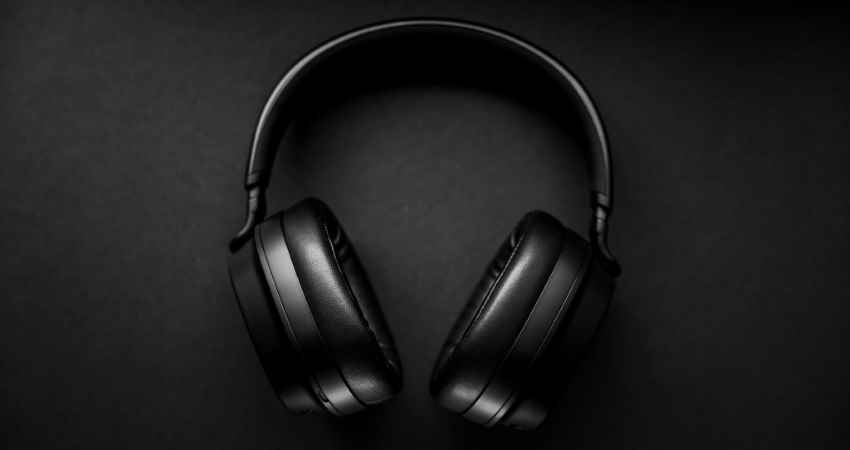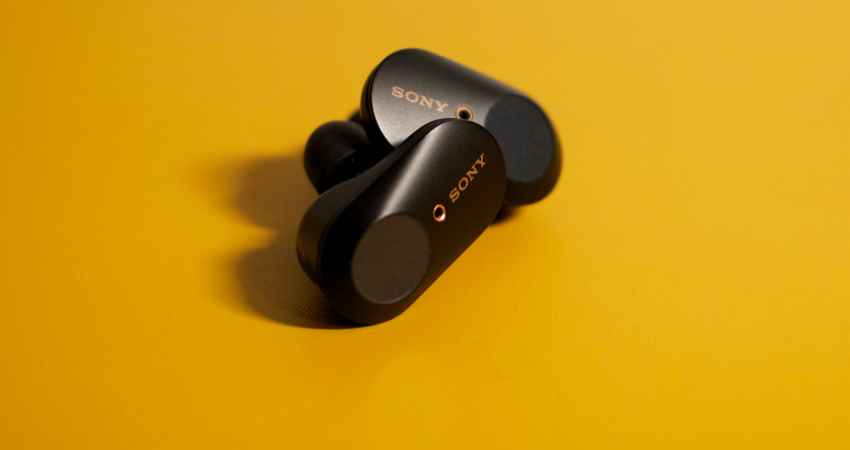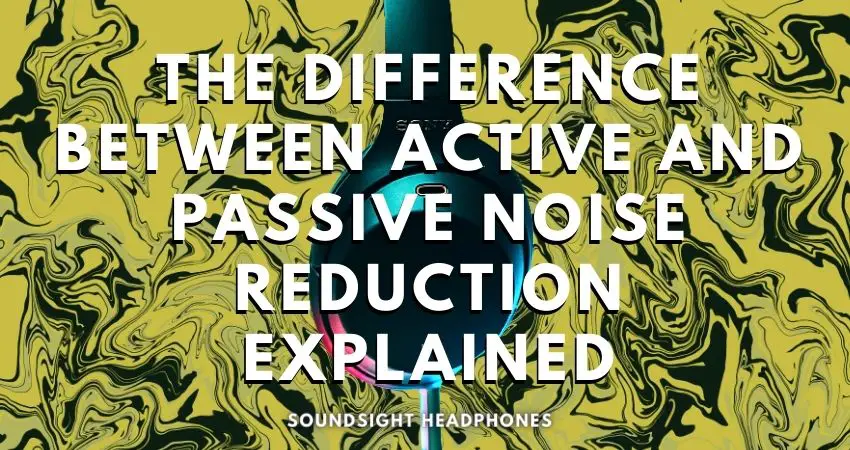There are two types of Noise Reduction: Active and Passive. Both are intended to reduce and eliminate unwanted noise, but the difference is in how they work, the advantages they bring, and the circumstances in which they work best. This article will provide a brief overview of noise reduction, discuss the differences between Active and Passive Noise Reduction in different situations, and answer some common questions specific to each type of noise reduction.
- What’s The Difference Between Active and Passive Noise Reduction?
- Passive Noise Reduction (PNR)
- What is passive noise reduction?
- Why would I want passive sound isolation instead of active noise canceling?
- Why passive noise reduction is important for headphones?
- What’s a good level of sound attenuation?
- What type of headphones have the best passive noise reduction?
- Does passive sound insulation have drawbacks?
- Does passive noise reduction affect sound quality?
- Active Noise Cancelling (ANC)
- Conclusion
What’s The Difference Between Active and Passive Noise Reduction?
- Passive noise reduction is a process that uses barriers to reduce or eliminate sound waves. It’s often used in activities such as sleeping, studying, working, cooking, and reading.
- Active noise cancellation has the ability to cancel out ambient sound but does not have the same effectiveness as passive noise reduction. Active canceling better reduces high-pitched sounds like those from airplanes or motorcycles.

Passive Noise Reduction (PNR)
What is passive noise reduction?
I will tell you why passive noise reduction is important in a concise but complete explanation. It’s not always about what we hear but also about what we don’t hear. Passive noise reduction (or passive sound isolation) can help you live a fulfilling life and avoid hearing symptoms such as ringing in the ears, tinnitus, and even deafness, which result from prolonged exposure to loud sounds.
The term passive noise reduction is often used for closed-back headphones, in-ear headphones, and earmuffs. Such headphones have sound-insulating properties to enjoy music without being bothered by loud, interrupting noises. Good passive soundproofing allows you to listen to your favorite music or podcasts without having to turn up the volume too loud to cover the noise.
Passive noise reduction is when the materials used to make the headphones reduce ambient noise, so you pay for the noise reduction upfront, or you could say it’s already included. Passive noise reduction works by absorbing sound that comes in contact with materials (leather, foam, velvet, wood, plastic), regardless of their frequency range.
Some frequencies are strongly affected by the materials, while others can pass through. This is why some headphones are suitable for studying or working, and others are not.
Why would I want passive sound isolation instead of active noise canceling?
Suppose you choose between regular headphones or IEMs and a headphone with ANC; which one will you choose? Many people may prefer headphones with ANC because they know that the technology could block out distracting noises and allow them to focus on their music. And it is true. But which one is better?
Passive noise reduction is the opposite of active noise canceling. Active noise canceling uses electronic circuitry to actively remove ambient sounds.
There are four reasons why passive noise canceling headphones are better:
- They don’t alter the sound response
- Don’t require batteries
- Offer high overall sound isolation
- Inexpensive.
It is much more convenient when your headphones don’t need to contain a battery source to maintain the ANC system or affect the playback sound with the electrical interference. Moreover, passive noise isolation headphones come with a more consistent sound insulation performance than ANC headphones.
Lastly, passive sound isolation can be found in a much cheaper price range when compared to active noise-canceling headphones and the numerous choices
Why passive noise reduction is important for headphones?
Passive noise reduction is more important because unless you buy a headphone with an open design, closed-back headphones provide a good level of noise reduction that offers a good listening experience, especially in loud environments.
Just because a headphone or headset has its ear cups sealed on the back, it doesn’t mean that it provides a good sound level for background music, movies or gaming. Sound leakage is also an issue in poorly designed headphones. A level between -10 and -15 dB of noise isolation is normal; thus, anything above that threshold is considered above average.
For closed-back headphones, an airtight and closed design refines the bass response and improves overall quality, making closed headphones sound engaging and full.
What’s a good level of sound attenuation?
As previously mentioned, anything above -15 dB of noise attenuation is considered above average. A good level of noise attenuation is around -12 to -15 dB for a closed-back headset or headphone, while open-back headphones have a noise reduction between 0 dB and 5 dB.
This value doesn’t indicate how much all audible frequencies are reduced. It merely represents the average sound insulation of the headphones. Certain frequencies will be reduced more than others, and in the case of passive sound isolation, it’s the highs that get attenuated the most.
Because of that, it doesn’t mean that passive noise isolation is bad; just that low and mid-range frequencies still carry a lot of noise, so one should expect to hear a little bit of noise while using active noise reduction.
Another important thing to understand is the scale of decibels. For noise isolation, the value isn’t on a linear scale. Instead, it’s on an exponential scale, meaning the difference between -20 and -30 dB is not 50%, but double the sound attenuation; thus, you can expect two times more passive attenuation than a headphone that only offers an average attenuation of -20 dB.
Sound intensity doubles every 3dB, whereas loudness (perceived volume) doubles every 10 dB. In short, the higher the noise reduction, the bigger the difference. Read a more thorough explanation about how decibels scale.
What type of headphones have the best passive noise reduction?
In-ear headphones with deep inserts and foam tips create a tight acoustic seal that isolates the ear canal better than most over-ear headphones. This cuts off your ability to hear powerful basses, but the noise reduction provided is huge. The best way to achieve maximum passive reduction with in-ear buds is to use a pair of in-ear headphones with deep inserts and multiple ear tips to fit your ear perfectly, such as foam, triple flange, or silicon (varies with headphones).
Etymotic ER4XR comes with four dual flange silicone pairs, two triple flange pairs, and foam ear tips. The package is generous and offers you multiple choices to pick up the best fitting tips for your ears. But an even more impressive is that ER4XR offers up to -42 dB of sound attenuation, making them the best passive noise-isolating headphones.
If you’re looking for an over-ear set of headphones, the Sony WH-1000XM4 and Bowers & Wilkins PX are great choices, as they offer up to a whopping -25 dB of passive noise reduction. Most closed-back headphones with good passive noise reduction come with ANC to complement the weak spots of passive noise cancellation.
Without ANC, closed-back headphones depend on the thickness, density, padding, and build quality of the ear cushions and backside of the ear cups. As such, if you want a regular headset with good sound isolation, pay attention to these features. The Sennheiser GSP 600, for example, has thick cushions and offers some of the best passive noise reduction for a pair of gaming headphones.
Does passive sound insulation have drawbacks?
In a nutshell, passive noise reduction is less effective than active noise cancellation with frequencies in the first five-six octaves. It suppresses high-pitch frequencies more successfully from the higher octaves.
Considering most sounds you hear daily are in the 250 – 6000 Hz range, passive noise reduction does offer a great benefit, but you’ll benefit from even more if you add active noise cancellation.
Does passive noise reduction affect sound quality?
The mass of the materials and their shape are elements that influence the sound response of a headphone. In the case of passive noise reduction, materials with greater mass are used to reduce sound pressure. If we compare extreme examples: open and closed headphones, both have a different sound response due to the difference in design and acoustic properties.
Materials that block out outside noise improve the quality of your listening experience and impact the overall sound response of your headphones. But that doesn’t mean they negatively affect playback performance. On the other hand, using the wrong materials for ear cushions or ear pads that are thicker, thinner, or denser than the headphones were tuned for can result in a poorer sound response.
Open-back headphones’ sound response can suffer when equipped with less breathable and thicker earpads as they change the distance from drivers to ears and change the acoustic properties of the headphones, impairing open sound perception, one of the key benefits of having an open-back design.

Active Noise Cancelling (ANC)
What is active noise cancellation?
Active noise cancellation, abbreviated ANC, is a technology used in headphones and other devices to reduce or eliminate ambient sound. In this sense, they are similar to passive noise reduction, except that they need a battery to work, can alter the sound response and may not be as consistent, and sometimes do the opposite of what they are supposed to do and start generating white noise or background hum.
The most effective ANC systems attempt to reduce unwanted sounds by up to 15 dB or more depending on the technology used and how loud the sounds are, to begin with. Since noise-canceling has a relatively high cost, it is primarily included in higher-cost products such as premium true wireless noise-canceling earbuds, travel headphones, pilot headsets, office headsets, etc.
Types of ANC:
- Feedforward ANC
- Feedback ANC
- Hybrid Active Noise Cancellation
The most effective active noise canceling system is the hybrid active noise canceling system. This system combines the feedback ANC with feedforward ANC and has the two modes working together. Of course, they have issues too, such as high power requirement, high cost, and generating white noise. LINK HERE
How does ANC work?
It uses microphones to measure background noise and eliminate the ambient noise by creating anti-noise. The most basic type of ANC is Feedforward ANC. Feedforward ANC works by picking up the background noise that has been measured by the microphone, which is sent to the ANC circuit.
It reproduces anti-noise, which is played in the headphones. The noise from the outside and the reversed sound wave generated by the ANC cancel each other out.
Another type of ANC is “Feedback ANC,” which uses microphones in front of the drivers to process music playback and outside noises as if they were heard inside. The microphone picks up this information and sends it to the ANC circuit, which is inverse to the sound. In this way, the outside noise is eliminated, and you get a better sound.
There’s also the Hybrid Active Noise Cancelling System, which combines both Feedforward ANC and Feedback ANC to give you the best of both.
You can read more about how these Active Noise Cancelling systems work here: LINK HERE
What are the drawbacks of active noise cancellation?
It’s also important to know that the devices that use active noise reduction are more expensive. Right now, passive noise reduction is a far more cost-effective option.
If you just want to enjoy your music and have a passive sound barrier, don’t worry; we can guide you to the best sound isolating closed-back headphones on the market.
Battery or electrical power required
Feedforward and Feedback ANC are both economical and straightforward. They don’t consume a lot of battery but are also prone to inefficiencies. The ANC feedback + ANC feedforward hybrid is the most efficient active noise reduction system, but this active noise reduction technology requires a lot of power. Even if your ANC headphones have one of the lowest power consumption types, they still need to be charged!
White Noise Generated
More advanced ANC technologies, such as hybrid active noise cancellation, produce white noise when activated. You may hear white noise inside your headphones when the volume is low or when music is not playing, which is not desirable, especially if you want to use ANC headphones only for noise suppression.
Not very effective in high frequency range
When buying a pair of ANC headphones, you do it to get rid of people’s voices and traffic noise, right? They’re good for that, but ANC headphones are not designed to reduce high-frequency noise and deep bass.
High frequencies are faster and harder to cancel as it requires more processing power and more advanced circuitry to cancel out the noise. During your listening experience, you may hear a hissing or buzzing sound. This hissing noise is the sound of the ANC that doesn’t handle high frequencies perfectly.
On the other hand, low frequencies are effectively blocked, but deep basses under 20 Hz are another area where ANC performs horribly.
Is wearing ANC headphones all day bad?
You can always use noise-canceling headphones when exercising, playing a game, or commuting. The process by which background noise is canceled out is not harmful and does not affect you in any way. On the contrary, it will help you enjoy your music.
The reason ANC headphones are safe to use is due to how the sound waves interact with each other. The ANC circuitry generates a clean sound that is inverted and can only be noticed when the input sound is absent, which is never the case. So you don’t hear two separate sounds, but only one that is attenuated.
Listening to music with high volume for too long, on the other hand, is a bad idea regardless of the type of your headphones.
Active noise cancelling may induce vertigo when you’re using it for long periods as you get used to the low level of noise and are then no longer able to distinguish sounds in your environment.
Vertigo is a complex phenomenon that has been observed in airplane pilots and mountaineers, but it is also possible to have this feeling when using ANC headphones.
To avoid vertigo when using noise-cancelling headphones, use common sense: listen to your music at reasonable volumes, limit your exposure to ANC headphones and take breaks while wearing them.
Can ANC damage your hearing?
The possibility of hearing damage is reduced because ANC technology can cancel out ambient noise and does not allow it to reach your eardrum.
The auditory protection feature of ANC headphones is one of the reasons I like ANC headphones. Another reason is that this technology complements the headphones’ natural sound-isolating properties. The processing power behind it suppresses excessive low- and mid-frequency sounds that make up most of the sounds emitted by machinery, traffic, people, etc.
When is active noise reduction the most effective?
Since many closed-back headphones have natural passive sound isolation, it is important to know when we need active noise reduction and when passive sound reduction is sufficient.
A headphone with ANC is best for:
- Study: Nothing blocks people’s conversations like active noise-canceling headphones. Mid-range sounds – voices, whispers, and the chatter of nearby people – are best handled by ANC headphones.
- Traveling: It is easy to enjoy music as the sound of the jet engine will be blocked. Whether on train or plane, ANC is useful in all places with a lot of low-frequency sounds.
- In a library: An active noise cancelling headphone is the right choice for people who need a quiet atmosphere in order to study.
- In the office: For people who work in an office environment and are allowed to use headphones, a pair of ANC headphones will help them focus on their work by ignoring distractions, getting rid of keyboard clicks from their coworkers, chatting sound, and ventilation noise.
Conclusion
Both active and passive noise reduction are effective in canceling out unwanted background noises from people talking, whispering, keyboard tapping, trains, cars, and everyday noise produced by the environment. Both noise reduction methods are perfect if you’re looking to relax and concentrate with little distraction.
The main difference between active and passive noise reduction is that active cancellation is better at canceling low and mid-range frequencies, while passive is better at canceling high frequencies. It all comes down to personal preference and choosing the type of noise cancelling system that works best for you.
That’s all for now. I hope you have a wonderful day! Keep on reading to find other interesting articles. I hope you found this article about the difference between active and passive noise reduction interesting and helpful. If you have any question, leave a comment below
